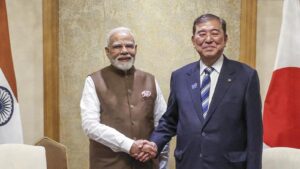GS2 – International Relations

Context
- PM Narendra Modi visited Japan (15th Annual India–Japan Summit with PM Shigeru Ishiba) before proceeding to China (Tianjin) for the SCO Summit.
- Last annual summit was held in India (2022).
- At a time of geopolitical turbulence (US tariffs, India–China tensions, East China Sea disputes, global supply chain disruptions), India and Japan reaffirmed the stability and forward-looking nature of their partnership.
Key Outcomes of the Summit
- Economic & Investment Cooperation
- Japanese businesses raised investment target in India to $68 billion.
- Around 170 MoUs signed with Indian partners.
- Adoption of a 2035 Vision Statement with 8 priority areas:
- Economic security
- Mobility
- Green technology transition
- Semiconductor cooperation
- Supply chain resilience
- Critical infrastructure security
- Connectivity
- Skill & technology partnerships
- Next-Gen State–Prefecture Partnership → boosting grassroots ties and direct flight connectivity.
- Strategic & Security Cooperation
- Updated 2008 Security Partnership →
- Annual NSA-level dialogue.
- Stronger engagement on Quad, Indo-Pacific security, UNSC reform.
- Semiconductors & Rare Earths: Japan to help India manufacture & process chips, crucial amid Chinese restrictions on rare earth exports.
- Showcased collaboration on High-Speed Rail (“Bullet Train”) project.
- Joint inspection of a semiconductor factory in Miyagi province.
- Regional & Global Issues
- Joint statement condemned:
- North Korea’s missile tests & nuclear programme.
- Cross-border terrorism (including Pahalgam attack) – but without direct mention of Pakistan.
- Highlighted importance of upcoming Quad Summit in India (despite uncertainty from US domestic politics).
Geopolitical Subtext
- Visit came after US tariff hikes threatening Indian exports.
- Modi’s Tokyo stopover was before talks with Chinese President Xi Jinping – signalling Japan’s importance as a strategic partner.
- Japan too faces:
- East China Sea tensions with China.
- Trade disputes with the US (led to cancellation of a delegation visit to Washington).
- Message: India–Japan ties remain stable & growing despite turbulence in US–China dynamics.
Background
India–Japan Relations:
- 1952: Official diplomatic relations established.
- 2000: “Global Partnership” announced.
- 2006: Upgraded to “Strategic and Global Partnership”.
- 2014 onwards: Special Strategic and Global Partnership under PM Modi & PM Shinzo Abe.
Key Areas of Cooperation:
- Economic:
- Japan: India’s 5th largest investor.
- Collaboration on Delhi–Mumbai Industrial Corridor (DMIC) & high-speed rail.
- Defence & Security:
- Malabar Exercise (with US).
- 2+2 dialogue at Defence & Foreign Minister level.
- Strategic: Shared vision of a Free, Open and Inclusive Indo-Pacific (FOIP).
- Technology: Semiconductors, clean energy, green hydrogen.
Quad (India, Japan, US, Australia):
- Aimed at rules-based Indo-Pacific order.
- Focus: supply chains, maritime security, critical tech, countering coercive strategies.




